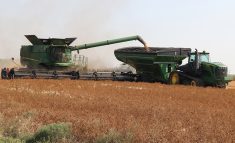Beavers will be short of water when the Red Willow Pork Farm goes
looking to recharge its dugout this spring.
If runoff stays sparse, the 1,200-sow operation northeast of Stettler,
Alta., plans to blow up a couple of beaver dams to get water, says
manager Shawn Charbonneau.
“We don’t have anything to back us up. We have a big reservoir and
three of the last five years we’ve had little to no runoff.”
For household water, the farm has two wells that flow at a gallon a
Read Also

Alberta honey business ‘thrives’ despite bumpy beginnings
Thrive Honey showcases its honey production in market where Alberta produces 40 per cent of all honey produced in the country
minute and usually run dry in the summer. The water runs into a sand
filter, is chlorinated and then passes through a reverse osmosis
process. Charbonneau plans to test house water every six months. He
sends the samples to a laboratory in Manitoba that does “the whole nine
yards” for $70. Alberta labs charge double that, he said.
Water quality and quantity are also concerns 700 kilometres to the east
on a farm near Raymore, Sask.
Vance Simpson plans to soften his hard water this year because minerals
are plugging up the nozzles in his sprayer. The Simpsons buy their
drinking water, even though the supply in their 50-year-old well is
adequate. They use the well water for laundry, washing and the toilets,
so are not worried about treating it.
“The last time I checked it was 20 years ago. As long as it keeps
running” there is no need to monitor its condition, he said.
The dry spring has already caused community wells in his area to run
low, Simpson said, and the heavy demand from farming hasn’t even begun
yet.
Ernie Oblander, reeve of the Rural Municipality of Mount Hope where
Simpson farms, said farmers are more water-conscious after bad water
killed residents in Walkerton, Ont., and sickened people in North
Battleford, Sask.
Oblander said there was discussion about water after the Prairie Farm
Rehabilitation Administration studied wells in the RM two years ago.
People “have the best of intentions of checking their water.”
He said the RM now does regular quality checks on six community wells
that had previously been monitored haphazardly.
But many farmers are like Oblander and Simpson, who buy drinking water
and rarely know what’s going on in their wells. Dry conditions in the
past year have made quantity a bigger problem.
Water shortage affects just about every RM, said Saskatchewan
Association of Rural Municipalities president Neal Hardy. There is no
federal, provincial or PFRA money to help farmers dig wells, which
could cost $5,000-$10,000.
“A small farmer with 50-60 head of cattle, it’ll take half the herd to
finance that,” Hardy said. “A lot can’t finance another debt.”
The water table in southern, central and eastern Alberta is dropping,
said Jack Hayden, president of the Alberta Association of Municipal
Districts and Counties. As a result, a lot of wells are being drilled,
and to deeper levels. Hayden said the province does not offer farmers
money to dig wells, but does have grants to transfer water.
The 70-year-old well on John Pearson’s farm northeast of Stettler is at
the lowest level he has seen.
“We need to be careful with the water we do have,” he said. “It’s
caused us to change how we shower and flush toilets. That’s
conservation. We do our laundry off the farm.”
Pearson, reeve of the County of Stettler, said the county is looking at
the costs of putting in a water pipeline to the Red Deer River to serve
the 5,200 people living there.
“You don’t have any development and growth without water,” he said.
In 1997, PFRA tested wells
in the Municipal District of Kneehill northwest of Drum-heller, Alta.
In that study and a similar one in 2000 in the RM of Mount Hope in
Saskatchewan, the PFRA found problems with the quality and quantity of
well water. It also found the two problems are linked.
John Lebedin of PFRA said prairie residents are especially reliant on
well water because surface water is drying up. Yet most have a “set and
forget” attitude toward their wells until a problem occurs. Then it’s
often too late and the well requires costly repairs or replacement.
His agency recommends all farmers monitor wells regularly and do
preventive maintenance by shock chlorinating once or twice a year. That
treatment should kill the pathogenic bacteria such as E. coli that can
cause illness or death and control the more common nuisance bacteria
that make water murky, smelly and hard.
Nuisance bacteria cause what is called biofouling, which can mean
plugging of the pump mechanism, or a slime or scale buildup in the
well. Unless farmers are checking their wells or become concerned about
the taste of their water, the biofouling bacteria will also eventually
slow the output of water. But most well owners don’t recognize the
problem and “may develop a false sense of security in the safety of
their water supply.”
In the two PFRA studies, biofouling led to wells being abandoned at an
average age of 18 years in Alberta and 15 in Saskatchewan. But Lebedin
said a well should last 50-70 years.
He said the agency thinks the two studies are typical of the prairie
situation. No studies have been done in Manitoba since drought is less
of a problem there.
















